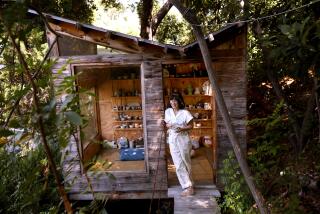Jon Serl; Folk Artist Produced Works of National Acclaim
- Share via
Jon Serl, an eccentric recluse who taught himself to paint in middle age and went on to become nationally recognized as a significant folk and primitive artist, has died at the age of 98.
Serl died peacefully in his bed June 23 in his ramshackle 25-room studio home in Lake Elsinore, his New York dealer, Randall Morris of Cavin-Morris Gallery, said Tuesday.
“As long as man walks the earth, there’ll be a Jon Serl painting somewhere,” the alternately modest and boastful Serl told The Times in 1970.
Morris called him “the last 19th-Century artist in America.”
In the latter half of his life, Serl painted more than 1,200 works, using scavenged scraps of wood, Masonite, plywood signs and canvas, and mixing his own pigments from the earth and the plants he grew. He began painting in 1949 when he moved into a San Juan Capistrano adobe older than the nearby mission, decided a blank wall needed a painting on it and didn’t have the 50 cents to buy the cheapest one he found.
For a couple of decades Serl refused to sell or exhibit any of his paintings. But as he grew older, he became concerned with preserving his work for future generations. His paintings are characterized by elongated, ethereal figures in bright colors, and have been compared to Cezanne, Matisse, Arthur Dove and Edvard Munch.
In 1970, Serl permitted the Municipal Arts Department of Los Angeles to organize a touring display of 41 paintings, and he slowly started selling to schools and eventually through galleries. At the time, Los Angeles art coordinator Curt Opliger described Serl’s paintings as “California primitives, authentic and of great importance.”
More exhibits followed and the Smithsonian Institution purchased two of Serl’s works for inclusion in its permanent folk art collection. Serl shows were staged at Newport Harbor Art Museum in 1982, at San Diego’s Oneiros Gallery in 1988 and in 1989, and at Laguna Art Museum in 1991 as part of a touring collection organized by the New York Museum of American Folk Art.
In 1990, the New York Times reviewed Serl’s work as “complex and sophisticated in both meaning and style” and described his images as “cartoonishly buoyant yet emotionally weighted, spiritual yet worldly and sexually aware.”
The paintings, which have sold for as much as $10,000, are now managed by the Jon Serl Trust and handled through the Cavin-Morris Gallery and through the Jamison-Thomas Gallery in Portland, Ore.
“I have a way of painting that is mine,” Serl once told the Los Angeles Times. “People can see in it whatever they want. They either like it--or they hate it.”
Whitney Museum curator Susan Larsen, who helped create Serl’s national following, told The Times in 1989: “Jon has a highly sophisticated mind and an extraordinarily broad perception of reality. He never takes anything at face value and is always searching for the deeper reality of things. His work encompasses everything from small-town parades to mystical interpretations of after-death experiences, but the theme that seems to color all his work is the intermingling of the spiritual and the physical.”
Born Joe Searles on an Indian reservation in Upstate New York, the future artist eschewed school and performed with his vaudevillian family as a singer, dancer and female impersonator. Moving to Denver, New York and eventually Hollywood, he worked as an actor, dancer, waiter, cherry picker, screenwriter and voice dubber for silent screen stars who could not make the switch to talkies. He used the names Slats, Ned Palmer, Jerry Palmer and finally Jon Serl spelled various ways.
He married and divorced three times and fathered two children, but remained an unreconstructed loner who frequently noted, “Monogamy bores me.”
“I don’t want any family and I’ve never had one,” he told The Times in 1988, adding that his paintings served as both his children and his friends.
After 22 years painting in the San Juan Capistrano adobe, Serl moved on to Lake Elsinore in 1971 because, he said, “the bird-watching is better.”
Chickens and Chihuahuas roamed the cluttered house where he rose, dressed in layers of swap-meet grunge, and began painting at 3 a.m. every day.
“I don’t know why I’ve lived so long,” he told The Times in 1989. “I’m tired and I’m not glad to be alive because it’s very hard. I’d like to be free and if it weren’t for my paintings, I probably would’ve died long ago.”
Funeral services are scheduled for 10 a.m. Friday at Evans Brown Mortuary in Lake Elsinore.
More to Read
The biggest entertainment stories
Get our big stories about Hollywood, film, television, music, arts, culture and more right in your inbox as soon as they publish.
You may occasionally receive promotional content from the Los Angeles Times.










